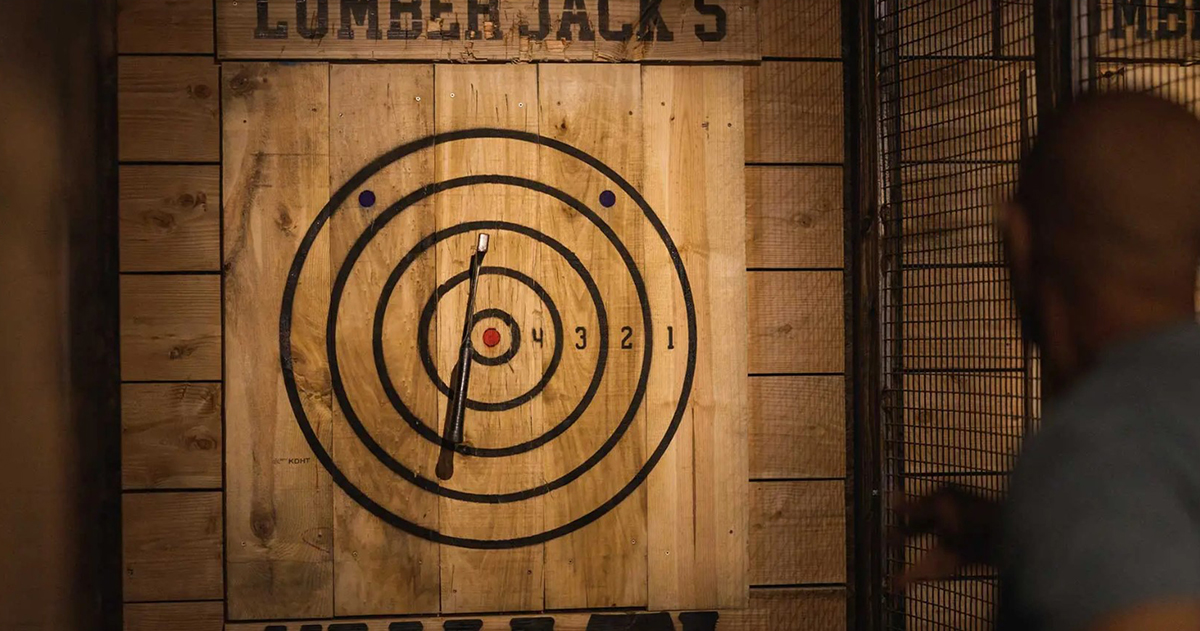Study the Axe Throwing Denver Scene: What You Need to Know
Study the Axe Throwing Denver Scene: What You Need to Know
Blog Article
The Fun of Axe Throwing: How This Sport Incorporates Skill and Adrenaline for a Blast
Axe throwing has arised as a captivating sporting activity that masterfully intertwines the need for specific skill with the thrill of adrenaline, offering participants a distinct and interesting experience. The act of tossing an axe in the direction of a target requires focus and method, concurrently fostering an environment of friendship and friendly competition.
The Origins of Axe Throwing
Axe throwing, a recreational activity that has gotten substantial popularity in current years, traces its origins back to old times. The earliest documents of axe usage in competitive contexts are located among the Celts and Vikings, who tossed axes for sporting activity as well as in battle training.
Middle ages European warriors, particularly during the Center Ages, exercised axe tossing as part of their martial training. The Francisca, a sort of throwing axe utilized by the Franks, came to be iconic for its harmful precision. This standard weapon was developed to be tossed at opponent guards and armor, showcasing its double utility in both sporting activity and fight.
In even more current background, axe throwing saw a rebirth in the logging camps of North America in the 19th and 20th centuries. Lumberjacks would certainly participate in pleasant competitors, examining their accuracy and strength by targeting at wood targets. This development from a survival ability to an entertainment task has actually led the means for its contemporary renewal, with devoted places and leagues now celebrating the sport globally.
Devices You Need
Understanding the rich history of axe tossing boosts the recognition of the sport's contemporary iteration. For competitive and entertainment axe throwing, the most frequently utilized type is the hatchet, generally weighing between 1.25 to 2 extra pounds with a take care of length of about 16 inches.
Just as crucial is the target. Law targets are constructed from timber, with softwood varieties like want or cottonwood being favored for their ability to hold the axe and soak up. The target is usually split into five concentric circles, each with a specific point worth, to help with rating.
Safety gear, however usually neglected, is essential. Protective handwear covers can boost grasp and stop sores, while closed-toed footwear are a must to protect feet from gone down axes (denver axe throwing). Lastly, a well-lit, roomy throwing area, complete with security obstacles, guarantees a controlled environment where individuals can concentrate on sharpening their abilities.
Standard Techniques Described
Understanding the essential methods of axe throwing is essential for both security and efficiency. The dominant hand must be positioned directly below the axe head, while the non-dominant hand supports the end of the deal with.
Next, concentrate on the stance. Stand with your feet shoulder-width apart, ensuring your body is stabilized. Your dominant foot should be slightly forward, lining up with your target. This positioning aids in maintaining security and guiding power precisely towards the target.

Safety First
Ensuring safety and security in axe throwing is critical to developing an injury-free and delightful experience. Safety and security measures start with the location format. A properly designed axe throwing center features clear separations in between throwing lanes, strong backgrounds to catch roaming axes, and non-slip flooring to avoid accidents. Additionally, adequate illumination is critical to assist individuals maintain aesthetic accuracy and spatial recognition.
Advantages of Axe Throwing
Axe tossing offers a myriad of benefits that expand past straightforward entertainment. Literally, it supplies a full-body workout, involving muscular tissues in the arms, shoulders, back, and core. The repetitive activity of tossing the axe also improves hand-eye control and fine motor skills. For those aiming to improve their total health and fitness, axe throwing can offer as a interesting and vibrant kind of exercise.
Psychologically, axe tossing calls for accuracy, emphasis, and strategy, making it an exceptional means to sharpen cognitive skills. The concentration needed to strike the Resources target can function as a type of mindfulness, allowing individuals to clear their minds and minimize stress. This psychological involvement can be specifically beneficial in assisting people create much better analytic abilities and psychological durability.
Socially, axe throwing is often appreciated in group setups, fostering team-building and camaraderie. Whether as component of a corporate occasion or a laid-back outing with close friends, the sporting activity motivates communication and cooperation. Additionally, the communal experience of finding out and enhancing together can enhance partnerships and develop lasting memories.
Final Thought

The earliest records of axe usage in competitive contexts are located among the Celts and Vikings, who tossed axes for sporting activity as well as in combat training. Release the axe when your hands are about at eye level, permitting the axe's all-natural view it now rotation to lead it towards the target.
A well-designed axe throwing center features clear separations in between throwing lanes, strong backgrounds to capture roaming axes, and non-slip flooring to protect against mishaps. Individuals must be advised on the right way to toss the axe and handle, stressing controlled, purposeful movements over strong tosses.
In recap, axe throwing stands out as a sport that masterfully integrates adrenaline, accuracy, and ability.
Report this page